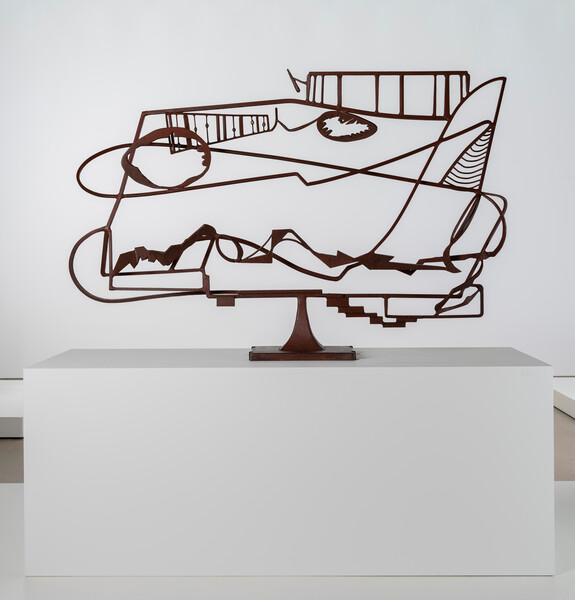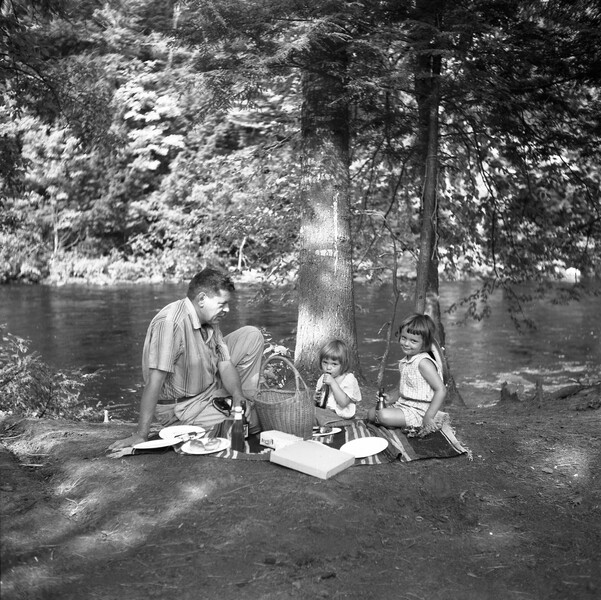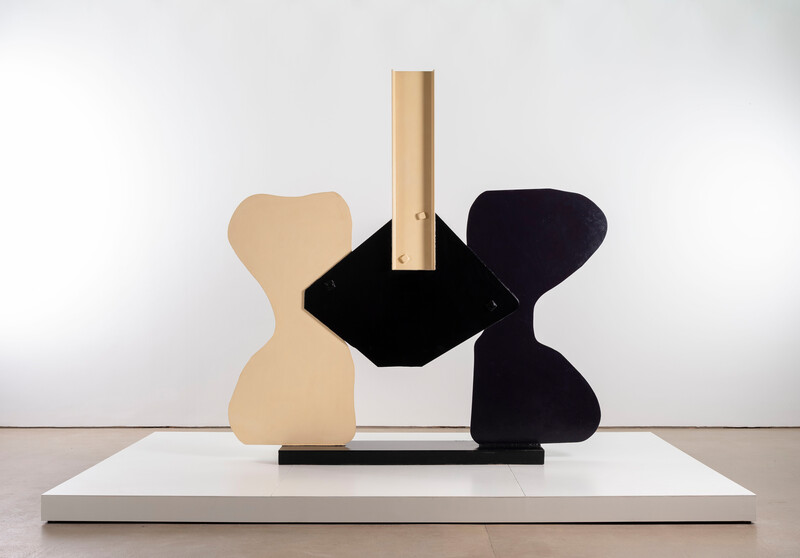Conversations
Curator Clare Lilley on David Smith

Clare Lilley with David Smith’s ‘Untitled (Candida)’ (1965) at Yorkshire Sculpture Park © 2019 The Estate of David Smith, Licensed by VAGA at Artists Rights Society (ARS), NY. Courtesy YSP. Photo © Jonty Wilde
Born in 1906 in Decatur, Indiana, David Smith is known for his use of industrial methods and materials, and the integration of open space into sculpture. One of the foremost artists of the twentieth century, Smith expanded the notion of what sculpture could be. On the occasion of the landmark exhibition ‘David Smith: Sculpture 1932–1965’, we spoke with curator Clare Lilley, Yorkshire Sculpture Park Director of Programme, about the lasting impact of Smith's deeply humanist vision.
Clare Lilley on the significance of Sprays in David Smith’s practice, June 2020
When did you first encounter the work of David Smith?
I was a student, reading the History of Art at Manchester University and studying with the late great art historian, Dr Andrew Causey. It was through him I first saw images of David Smith’s sculpture and I remember how eloquently he spoke about Smith and his importance. My memory of those projected slides is incredibly vivid, although it wasn’t until 1993 at the Royal Academy’s ‘American Art in the 20th Century’ exhibition that I first saw ‘The Royal Bird’ (1948-49) together with other works and was bowled over. It utterly thrills me that one of those sculptures, ‘Voltri IV’ (1962) from the Kröller-Müller, is in our exhibition.
David Smith wanted his sculptures to be experienced in nature, in changing light, weather and seasons. What is the significance of bringing Smith’s sculptures to Yorkshire Sculpture Park?
The essence of Yorkshire Sculpture Park is the relationship between sculpture and the open air—the interplay between the two and the wonders that they stimulate. It is the basis for virtually everything we do. And it is for this reason that for decades we have harboured the desire to show David Smith—an artist no less influential than Picasso, whose sculpture is so forcefully influenced by his understanding of landscape. And so, the works seen in the Yorkshire landscape positively dance with the ever-shifting sky, light and weather. This is how Smith wanted them to be seen. Moreover, being able to see the extent of his production in our Underground Gallery, where natural light plays across the sculptures, is integral to this exhibition. It allows us to see a level of detail in form and surface, their chromatic articulation, in a way that likely has never been seen before nor will be seen again. Really, this is a once in a lifetime opportunity to see Smith in these conditions.

David Smith, Hudson River Landscape, 1951 © 2019 Whitney Museum of American Art, New York, Licensed by Scala. Courtesy YSP. Photo © Jonty Wilde

Sculpture group—‘Agricola Head’, ‘Chain Head’ and ‘Saw Head’ (all 1933)—at Bolton Landing, New York NY © The Estate of David Smith, Licensed by VAGA at Artists Rights Society (ARS), NY
Can you describe Smith’s early works and development as an artist?
We begin the exhibition in 1932, the year that Smith made his very first sculptures—assemblages of wire, shells and painted wood that still seem especially fresh and contemporary. They reflect Smith having seen illustrations of constructivist, cubist and surrealist works made in Europe and Russia. In the following year he shifts ground and produces what are probably the first welded sculptures made in the US—‘Saw Head’ and ‘Chain Head’—again using found objects but this time objects associated with the workshop and industry, making use of skills he had learned at 19 when working as a welder for a summer job. The very intricate and disturbing ‘Medals for Dishonor’ (1939-40) reflect his political and personal response to the widespread degradation he had witnessed in the 1930s, both as a result of the Great Depression in the US and the inexorable creep towards yet another world war that he witnessed in Europe and Russia in the late ‘30s.
During the War, Smith was employed in Schenectady, welding M7 destroyer tanks. This enabled him to hone and learn new skills, but he was frustrated by having so little time to make his own sculpture. ‘Home of the Welder’ (1945) resonates with his dissatisfaction as well as a declining domestic situation. This sculpture, like the wonderful ‘Reliquary House’ from the same year, shows Smith’s incredible mastery of welding, cutting and piecing together intricate pieces of steel with found and cast metals to make these intense psychological arenas. By the time of ‘Hudson River Landscape’ (1951), Smith is all but flying! This dynamic, audacious sculpture riffs off Smith’s consciousness of the regular journey he took between Poughkeepsie and Albany in upstate New York—a work in which he’s eschewed millennia of sculpture-making, taking out the core and literally throwing steel into the air and drawing in space.

Installation view, ‘David Smith: Sculpture 1932-1965’, Yorkshire Sculpture Park, Wakefield, United Kingdom, 2019 © The Estate of David Smith, Licensed by VAGA at Artists Rights Society (ARS), NY. Courtesy Yorkshire Sculpture Park. Photo © Jonty Wilde
In 1950, Smith was awarded a Guggenheim Fellowship and for the first time in his life was able to concentrate on making sculpture without needing to work as a welder or teacher. Within the decade he remarried, and his two children were born. Living full-time at Bolton Landing on Lake George in the Adirondacks, the ‘50s sculptures are open, confident, bursting with life and love. Often made in series—‘Tanktotem’, ‘Agricola’ and ‘Forging’ amongst them—they are spliced by air and light, they incorporate old-time tools, off-cuts, newly purchased boiler lids, small bronze casts, waste and bought steel. They are the output of a man compelled to make a body of work that he knew had no precedent, that spoke of the unique energy of the United States, its self-conscious commitment to industry and work ethic, its weather and landscape, its individualism, its ‘go it alone’ sensibility. At YSP, these works are brought together in a white space filled with light where the nuance of their manufacture and form is clearly visible.
The middle galleries are an explosion of scale and color, with seminal sculptures from the ‘60s that include ‘Wagon II’, ‘Gondola II’ and ‘Untitled (Zig VI)’, all from 1964 yet all quite different in form and substance. They were made two years after his incredible 30-day residency at a recently abandoned factory in Voltri, northern Italy where, with material, equipment and skilled artisans, Smith produced a phenomenal 27 sculptures. Voltri represented a fantastically creative expansion and one can only speculate on what might have been, had Smith’s life not been dramatically cut short in 1965. I also want to mention that I’m incredibly gratified that just outside the gallery we have a number of works that have never been exhibited in the UK, including ‘Untitled (Candida)’ (1965) and the exceptionally subtle yet cogent ‘Primo Piano III’ (1962). Also, Tate’s stainless steel ‘Cubi XIX’ (1964) and other works look incredible, playing in the shifting light and silhouetted against the huge dark green Victorian yew hedge. It will be exciting to see how they change through the autumn and winter months.
Is there a lesser known work you feel more people should know about?
When visiting Bolton Landing I saw the crate containing ‘Torso’ (1937) tucked away in storage and while it’s a sculpture that has been shown before, it is hardly well known and is unique in Smith’s career. It appears to have been an iron pipe that Smith has split, forced open and beaten into a classic female form. It was made after he had spent a winter in Greece studying ancient art and it is a transition sculpture, not yet Smith in full voice, but I love it for all the indisputable force that has gone into its cold forging—essentially blacksmithing—the multiple raw hammer blows exerted by Smith to make this very simple and beautiful work that is full of vigor and fortitude.

David Smith, Cubi XIX, 1964. Courtesy Tate and Yorkshire Sculpture Park. Photo © Jonty Wilde

David Smith with Candida and Rebecca, Edgecomb Pond, Bolton Landing, New York, c.1959 © The Estate of David Smith, New York / Licensed by VAGA at Artists Rights Society (ARS), New York. Photo: David Smith
What does the exhibition teach us about David Smith’s character and vision?
David Smith was a man with prodigious energy and vision, tenacity and muscularity. He said that his work was always two years behind his vision and in a sense he was always playing catch-up, never settling for the obvious or easy, switching tack as soon as a set of ideas had been resolved. Whilst Smith was a regular visitor to New York City, his preferred place was the relative isolation of Bolton Landing, away from the chatter of the art world, and that singularity of purpose is very evident here. In the dedication of a number of sculptures to his daughters, Rebecca and Candida, we also see a man devoted to and highly respectful of his children. He was certain of his place in the history of art and told the girls that these dedications were messages to them when later in their lives they would view his works in the world’s museums.
How does painting play a role in the work of David Smith?
Smith’s principle training was from the Art Students League in New York during the late ‘20s, and that was in painting—as a sculptor he was essentially self-taught. He was fantastically knowledgeable about the history of art and understood the thousands of years’ history of polychrome sculpture; even in the 1932 Constructions we see forms that are not painted flat white but are complex, scumbled white/grey, with elements picked out in contrasting colors. A primarily raw, steel work such as ‘Anchorhead’ (1952) has slivers of crimson and cream that respectively emphasise and recede those elements. By the 1960s, Smith’s handling of paint is in full flow, steel surfaces being treated as a canvas might with compound colors and strokes. Whilst steel and paint are fused, it seems to me that Smith is not seeking synthesis in these sculptures but is in love with both metal and pigment and the calm or flourish it brings to a whole composition.
In his appropriation of the materials and methods of ordinary industry, coupled with an extraordinary technical dexterity and intellectual capacity, Smith gives us a humanitarian vision.
Can you tell us about the late work ‘Untitled (Candida)’ (1965)?
‘Untitled (Candida)’ is one of the very last works Smith completed before his death. It is positioned at the top of the Bothy Garden, overlooking our 18th-century landscape; the highest point of the Park, where it embraces the landscape and the sky. It is constructed from subtly overlapping sheets of stainless steel, their welds contributing to the gradation and texture of the sculpture and showing Smith’s great skill in handling plates of steel—learned while working on tanks during World War II and developed further as he switched from oxyacetylene to the faster arc welding. For Smith, stainless steel was the epitome of materials suited to sculpture outdoors. Not only is it weather and rust-proof, requiring little or no maintenance, but stainless steel reflects and absorbs the world around it and Smith’s grinding marks—in some respects equating to paint—make ‘Untitled (Candida)’ light and expansive. This removal of weight, of the core, is one of Smith’s great innovations to the history of sculpture and by literally extracting the centre of the sculpture, allowing us to see the parkland and sky beyond, ‘Untitled (Candida)’ moves into the metaphysical.

David Smith, Gondola II, 1964 © The Estate of David Smith, Licensed by VAGA at Artists Rights Society (ARS), NY. Courtesy YSP. Photo © Jonty Wilde

David Smith welding in Brooklyn Terminal Iron Works, c. 1937 © The Estate of David Smith, New York / Licensed by VAGA at Artists Rights Society (ARS), New York
How would you define David Smith’s legacy and contribution to sculpture? What do you hope audiences can learn from to seeing his work today?
Smith’s influence is long and venerable, including John Chamberlain, Anthony Caro, Mark di Suvero, Donald Judd and the development of minimalism, through to what I see particularly in female sculptors who are in full command of their concepts and material—artists like Monika Sosnowska, Virginia Overton, Carol Bove and Tatiana Trouvé. Often Smith’s work is characterized as brutish but I think here audiences will see something far richer, more diverse, and lyrical. In his appropriation of the materials and methods of ordinary industry, coupled with an extraordinary technical dexterity and intellectual capacity, Smith gives us a humanitarian vision.
This year’s Yorkshire Sculpture International responds to Phyllida Barlow’s statement that ‘sculpture is the most anthropological of the art forms’. How does this apply to the work of Smith?
Phyllida’s provocation refers to artists who see themselves as connected to cultural histories and who manipulate material. David Smith aligned himself to an anthropological trajectory, embracing a creative continuity that connects humanity across millennia, from prehistoric artefacts to the art of tribal communities, and to that of his own day. In this exhibition, for the first time we have taken from the walls of Smith’s home at Bolton Landing some of the objects that he chose to live with, many of them collected during his travels in Europe in the ‘30s. They range from a ceremonial knife from Africa and a Spanish spur to an antique lock mechanism and a manhole cover from Brooklyn. Through the materials and processes of his workshop (the ‘shop’ as he called it), Smith was deeply connected to ancient traditions of making and fettling—this social and human impulse that marks human life on earth. I can’t tell you how gratifying it has been to get to know this work, to present it here in Britain and especially in Yorkshire, which is still so vital to our nation’s industry.
Yorkshire is the birthplace of pioneering sculptors Barbara Hepworth and Henry Moore. What does David Smith’s work share in common with these artists?
Moore, Hepworth and Smith were born respectively in 1898, 1903 and 1906 and they had a shared understanding of world conflict and human deprivation which I think contributed to a profound desire for peace, to a belief in the value that culture contributes to human behaviour and to society. The abstract visual languages they developed were necessarily different to those of the past. They are aspirational and transcendent, whilst being grounded in the realities of geology, industrial endeavor, and the forces of the natural world. Though using different methods and materials, all three sought to undo the ‘mass’ of sculpture, to pierce and deconstruct volume, to bring air and space into sculptural considerations of the solid. And in the context of post-war agnosticism, doing so carried the sense of a spiritual undertaking. All three artists embraced the open air—the sky, the weather, the ever-changing light and the caprice of seasons—those factors that allow sculpture to breathe and to evolve. I suppose you could say all three artists created works which assert the most basic elemental forces and combine them with a sense of the aspirational, with a sense of hope. Hope through strength.
Clare Lilley is Director of Programme at Yorkshire Sculpture Park and curator of ‘David Smith: Sculpture 1932-1965’. This exhibition charts the development of Smith’s unique visual language over four decades, bringing together a number of his sculptures in the open-air that are rarely seen outside the United States. On view from 22 June 2019 until 5 January 2020, ‘David Smith: Sculpture 1932-1965’ is a feature exhibition in the inaugural Yorkshire Sculpture International, a partnership between the Henry Moore Institute, The Hepworth Wakefield, Leeds Art Gallery and Yorkshire Sculpture Park.
Opening 27 September 2019 at Hauser & Wirth Somerset, ‘David Smith. Field Work’ will further explore Smith’s diverse visual language and multifaceted creative process. Curated by the artist’s daughters Rebecca and Candida Smith, co-presidents of the David Smith Estate, the exhibition will situate itself between the drawn image and sculpted form to investigate the relationship between the two parallel practices.
